How much does the IAS score depend on facts and statistics? It depends actually. The IAS exam is designed to test many areas of your intelligence and awareness out of which your knowledge base is just one part.
This means that you cannot afford to ignore facts and statistics. But there is an infinity of data out there, so how much will you memorize?
More so when it comes to the Mains exam, where direct factual questions are rarely asked. Your comprehension and analysis of events around you will be tested. This is true for GS papers but especially true for the Essay paper.
A common piece of bad advice about the Essay paper is that you should add data and facts in your Essay to make it sound objective.
However you must keep in mind that data and statistics must NOT come at the cost of the quality of your arguments or your flow and structure in the essay. Focusing on facts in your essay more than the actual points and arguments is missing the penny for the pound- the pound in this case being your IAS score.
Moreover, remembering facts is hard. And you want your mind free from the tedious task of recalling facts in the exam because you will have only a few precious minutes during the exam to think about your arguments, organize them and present them to the examiner. So, which facts will you memorize? How many will be enough?
Not to worry. In order to solve this problem and to make your life easier, I have compiled a ready reckoner of facts and statistics which will be extremely easy to recall in the exam- called the FACT CHEAT.
It is called so because this compilation consists of the kinds of facts which are perfectly usable and appropriate in the Essay exam. I have tried to filter the ocean of facts and data to the optimal amount of data points which you should know before going into the exam to aid your IAS score.
This compilation will be ready usable in the essay exam, you will not need to memorize anything more and hopefully just WATCHING the images will be enough to register some of the facts in your mind.
In fact, you might even catch some questions being asked in the IAS exam and be able to answer based on this fact-cheat.This will help in increasing your IAS score in not just the Essay paper but in the Mains exam overall.
IAS score Booster Fact-Cheat
After spending hours searching for the perfect source of data and facts from the internet, I finally hit gold when I found the UNITED NATIONS website.
I found that specifically, the 17 SDG (Sustainable Development Goals) information furbished on the official of the United Nations is god-send for UPSC aspirants. The issues involved in the SDG are the biggest issues facing all of humanity. By default, these are also the biggest issues facing India.
The list of issues has been very carefully drafted by the United Nations and covers topics from poverty to education. These SDGs are fundamental to the idea of inclusive growth in the world and apply specially to India which is one of the most populous nations in the world consisting of millions of people affected by these goals.
This Fact-Cheat covers the effects of the Covid-19 pandemic which makes it highly relevant from the point of view of General studies and the upcoming IAS exam in general.
Therefore, do not be surprised if you find some direct questions in the IAS exam from this fact-cheat.
You can read about the pattern of the entire IAS exam in a super-simplified manner here.
I am reproducing the facts and images from the UN website here in one page for ease of perusal but you can also go directly to the source from this link.
You can simply save the infographics on your phone or laptop and look at them every time to time, which will serve as good revision.This should be enough to get an edge in your IAS score for the Essay paper.
United Nations SDG 1- No Poverty

- According to the most recent estimates, in 2015, 10 percent of the world’s population or 734 million people lived on less than $1.90 a day.
- Southern Asia and sub-Saharan Africa are expected to see the largest increases in extreme poverty, with an additional 32 million and 26 million people, respectively, living below the international poverty line as a result of the pandemic.
- The share of the world’s workers living in extreme poverty fell by half over the last decade: from 14.3 per cent in 2010 to 7.1 per cent in 2019.
- Even before COVID-19, baseline projections suggested that 6 per cent of the global population would still be living in extreme poverty in 2030, missing the target of ending poverty. The fallout from the pandemic threatens to push over 70 million people into extreme poverty.
- One out of five children live in extreme poverty, and the negative effects of poverty and deprivation in the early years have ramifications that can last a lifetime.
- In 2016, 55 per cent of the world’s population – about 4 billion people – did not benefit from any form of social protection
United Nations SDG 2- Zero Hunger
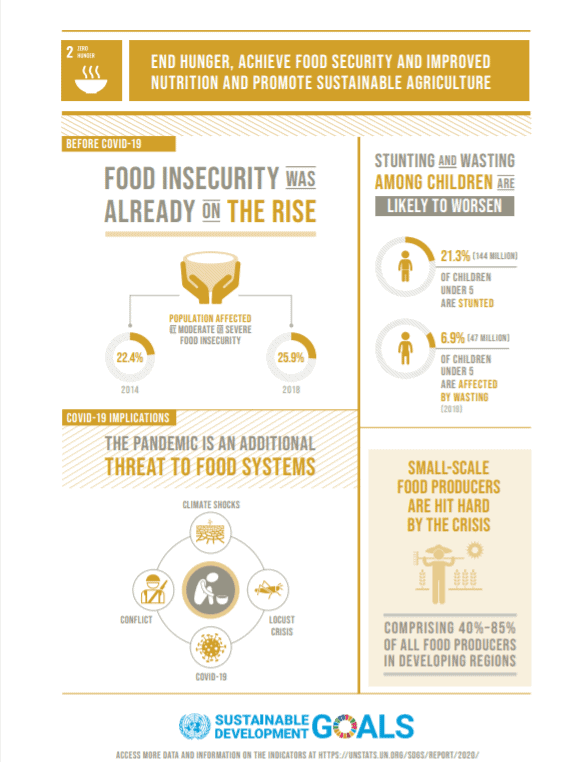
- Current estimates are that nearly 690 million people are hungry, or 8.9 percent of the world population – up by 10 million people in one year and by nearly 60 million in five years.
- The majority of the world’s undernourished – 381 million – are still found in Asia. More than 250 million live in Africa, where the number of undernourished is growing faster than anywhere in the world.
- In 2019, close to 750 million – or nearly one in ten people in the world – were exposed to severe levels of food insecurity.
- An estimated 2 billion people in the world did not have regular access to safe, nutritious and sufficient food in 2019.
- If recent trends continue, the number of people affected by hunger will surpass 840 million by 2030, or 9.8 percent of the global population.
- 144 million children under age 5 were affected by stunting in 2019, with three quarters living in Southern Asia and sub-Saharan Africa.
- In 2019, 6.9 per cent (or 47 million) children under 5 were affected by wasting, or acute under-nutrition, a condition caused by limited nutrient intake and infection.
United Nations SDG 3: Good health and well-being
Child health
- In 2018 an estimated 6.2 million children and adolescents under the age of 15 years died, mostly from preventable causes. Of these deaths, 5.3 million occurred in the first 5 years, with almost half of these in the first month of life.
- Despite determined global progress, an increasing proportion of child deaths are in Sub-Saharan Africa and Southern Asia. Four out of every five deaths of children under age five occur in these regions.
- Children in sub-Saharan Africa are more than 15 times more likely to die before the age of 5 than children in high income countries.
- Malnourished children, particularly those with severe acute malnutrition, have a higher risk of death from common childhood illness such as diarrhoea, pneumonia, and malaria. Nutrition-related factors contribute to about 45per cent of deaths in children under-5 years of age.
Maternal health
- Over 40 per cent of all countries have fewer than 10 medical doctors per 10,000 people; over 55 per cent of countries have fewer than 40 nursing and midwifery personnel per 10,000 people.
- In Eastern Asia, Northern Africa and Southern Asia, maternal mortality has declined by around two-thirds.
- Every day in 2017, approximately 810 women died from preventable causes related to pregnancy and childbirth.
- 94per cent of all maternal deaths occur in low and lower middle-income countries.
- Young adolescents (ages 10-14) face a higher risk of complications and death as a result of pregnancy than other women.
- But maternal mortality ratio – the proportion of mothers that do not survive childbirth compared to those who do – in developing regions is still 14 times higher than in the developed regions.
HIV/AIDS, malaria and other diseases
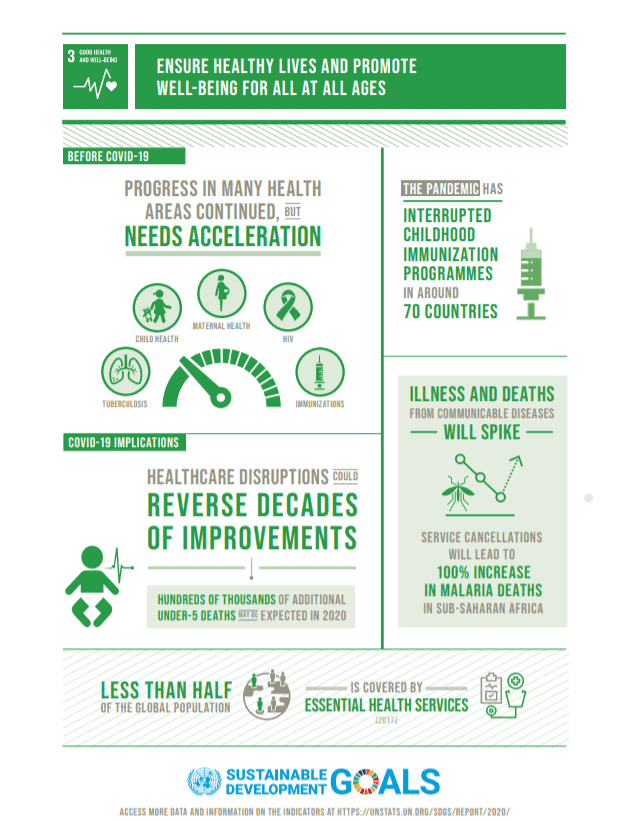
- 38 million people globally were living with HIV in 2019.
- 25.4 million people were accessing antiretroviral therapy in 2019.
- 1.7 million people became newly infected with HIV in 2019.
- 690 000 people died from AIDS-related illnesses in 2019.
- 75.7 million people have become infected with HIV since the start of the epidemic.
- 32.7 million people have died from AIDS-related illnesses since the start of the epidemic.
- Tuberculosis remains the leading cause of death among people living with HIV, accounting for around one in three AIDS-related deaths.
- Globally, adolescent girls and young women face gender-based inequalities, exclusion, discrimination and violence, which put them at increased risk of acquiring HIV.
- HIV is the leading cause of death for women of reproductive age worldwide.
- AIDS is now the leading cause of death among adolescents (aged 10–19) in Africa and the second most common cause of death among adolescents globally.
- Over 6.2 million malaria deaths have been averted between 2000 and 2015, primarily of children under five years of age in sub-Saharan Africa. The global malaria incidence rate has fallen by an estimated 37 per cent and the mortality rates by 58 per cent.
United Nations SDG 4 : Quality education

- Before the coronavirus crisis, projections showed that more than 200 million children would be out of school, and only 60 per cent of young people would be completing upper secondary education in 2030.
- Before the coronavirus crisis, the proportion of children and youth out of primary and secondary school had declined from 26 per cent in 2000 to 19 per cent in 2010 and 17 per cent in 2018.
- More than half of children that have not enrolled in school live in sub-Saharan Africa, and more than 85 per cent of children in sub-Saharan Africa are not learning the minimum
- 617 million youth worldwide lack basic mathematics and literacy skills.
- Some 750 million adults – two thirds of them women – remained illiterate in 2016. Half of the global illiterate population lives in South Asia, and a quarter live in sub-Saharan Africa.
- In 10 low- and middle-income countries, children with disabilities were 19per cent less likely to achieve minimum proficiency in reading than those without disabilities.
- 4 million refugee children were out of school in 2017
United Nations SDG 5 : Gender Equality

- Globally, 750 million women and girls were married before the age of 18 and at least 200 million women and girls in 30 countries have undergone FGM.
- The rates of girls between 15-19 who are subjected to FGM (female genital mutilation) in the 30 countries where the practice is concentrated have dropped from 1 in 2 girls in 2000 to 1 in 3 girls by 2017.
- In 18 countries, husbands can legally prevent their wives from working; in 39 countries, daughters and sons do not have equal inheritance rights; and 49 countries lack laws protecting women from domestic violence.
- One in five women and girls, including 19 per cent of women and girls aged 15 to 49, have experienced physical and/or sexual violence by an intimate partner within the last 12 months. Yet, 49 countries have no laws that specifically protect women from such violence.
- While women have made important inroads into political office across the world, their representation in national parliaments at 23.7 per cent is still far from parity.
- In 46 countries, women now hold more than 30 per cent of seats in national parliament in at least one chamber.
- Only 52 per cent of women married or in a union freely make their own decisions about sexual relations, contraceptive use and health care.
- Globally, women are just 13 per cent of agricultural land holders.
- Women in Northern Africa hold less than one in five paid jobs in the non-agricultural sector. The proportion of women in paid employment outside the agriculture sector has increased from 35 per cent in 1990 to 41 per cent in 2015.
- More than 100 countries have taken action to track budget allocations for gender equality.
- In Southern Asia, a girl’s risk of marrying in childhood has dropped by over 40per cent since 2000.
United Nations SDG 6 : Clean water and sanitation
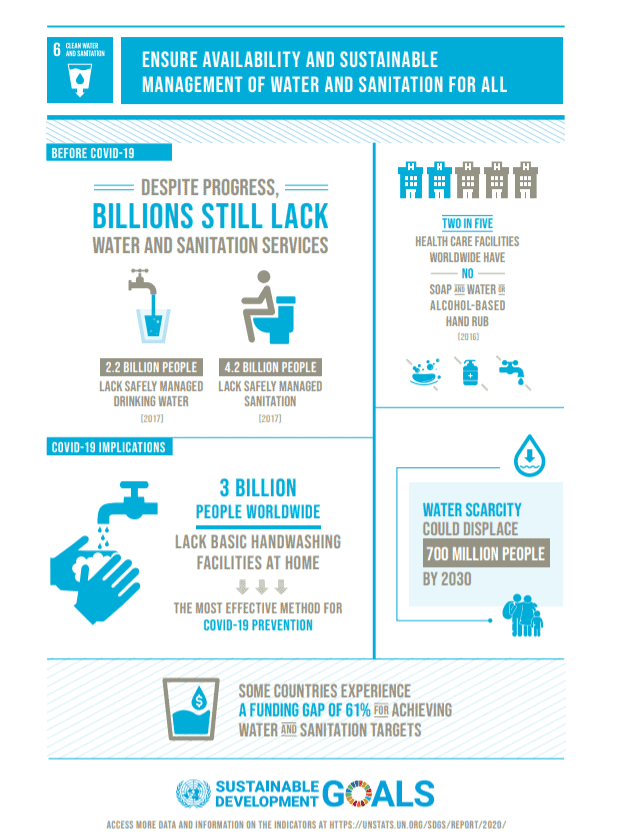
- 1 in 4 health care facilities lacks basic water services
- 3 in 10 people lack access to safely managed drinking water services and 6 in 10 people lack access to safely managed sanitation facilities.
- At least 892 million people continue to practice open defecation.
- Women and girls are responsible for water collection in 80 per cent of households without access to water on premises.
- Between 1990 and 2015, the proportion of the global population using an improved drinking water source has increased from 76 per cent to 90 per cent
- Water scarcity affects more than 40 per cent of the global population and is projected to rise. Over 1.7 billion people are currently living in river basins where water use exceeds recharge.
- 2.4 billion people lack access to basic sanitation services, such as toilets or latrines
- More than 80 per cent of wastewater resulting from human activities is discharged into rivers or sea without any pollution removal
- Each day, nearly 1,000 children die due to preventable water and sanitation-related diarrheal diseases
- Approximately 70 per cent of all water abstracted from rivers, lakes and aquifers is used for irrigation
- Floods and other water-related disasters account for 70 per cent of all deaths related to natural disasters
United Nations SDG 7 : Affordable and Clean Energy

- 13per cent of the global population still lacks access to modern electricity.
- 3 billion people rely on wood, coal, charcoal or animal waste for cooking and heating
- Energy is the dominant contributor to climate change, accounting for around 60 per cent of total global greenhouse gas emissions.
- Indoor air pollution from using combustible fuels for household energy caused 4.3 million deaths in 2012, with women and girls accounting for 6 out of every 10 of these.
- In 2016, the share of renewables increased at the fastest rate since 2012, up 0.24 percentage points, and reached almost 17.5per cent owing to rapid growth in hydropower, wind, and solar.
United Nations SDG 8 : Decent work and Economic Growth
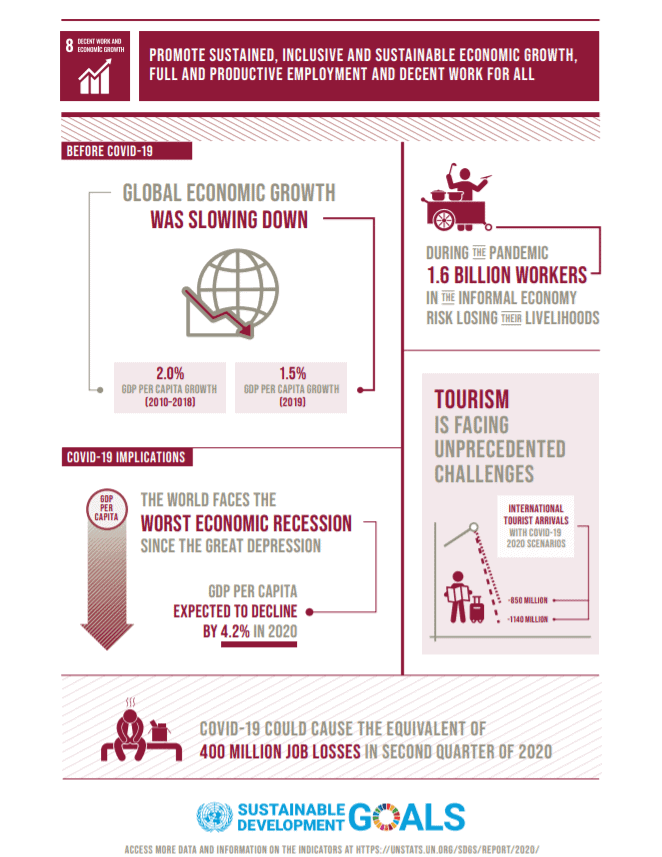
- The global unemployment rate in 2017 was 5.6per cent, down from 6.4per cent in 2000.
- Globally, 61per cent of all workers were engaged in informal employment in 2016. Excluding the agricultural sector, 51per cent of all workers fell into this employment category.
- Men earn 12.5per cent more than women in 40 out of 45 countries with data.
- The global gender pay gap stands at 23 per cent globally and without decisive action, it will take another 68 years to achieve equal pay. Women’s labour force participation rate is 63 per cent while that of men is 94 per cent.
- Despite their increasing presence in public life, women continue to do 2.6 times the unpaid care and domestic work that men do.
United Nations SDG 9 : Industries, Innovation and Infrastructure
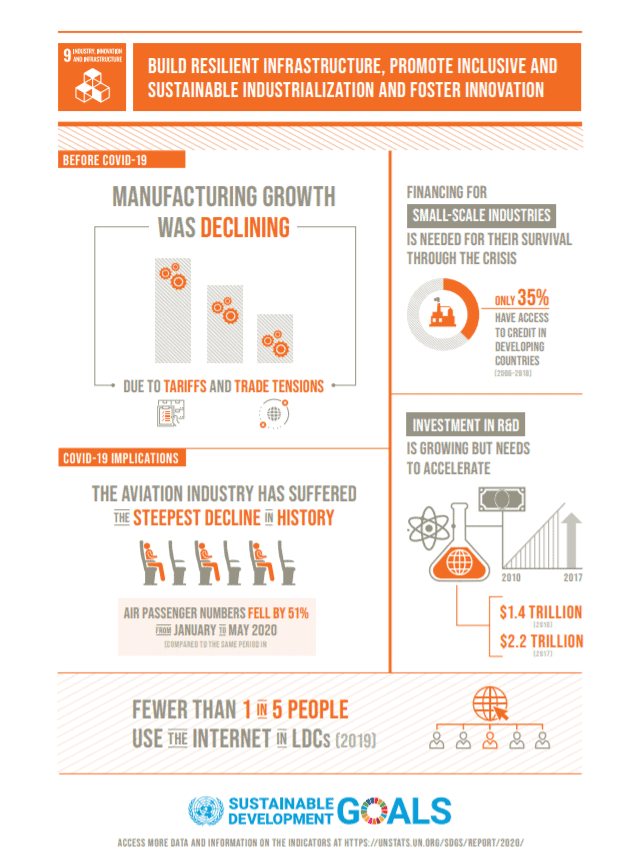
- In 2018, 96 per cent of the world’s population lived within reach of a mobile-cellular signal, and 90 per cent of people could access the Internet through a third generation (3G) or higher-quality network.
- 16 per cent of the global population does not have access to mobile broadband networks.
- The global share of manufacturing value added in GDP increased from 15.2per cent in 2005 to 16.3per cent in 2017, driven by the fast growth of manufacturing in Asia.
- Least developed countries have immense potential for industrialization in food and beverages (agro-industry), and textiles and garments, with good prospects for sustained employment generation and higher productivity
- In 2019, the amount of new renewable power capacity added (excluding large hydro) was the highest ever, at 184 gigawatts, 20GW more than in 2018. This included 118GW of new solar systems, and 61GW of wind turbines.
- Capacity investment in solar slipped 3per cent to $131.1 billion in 2019, while that in wind climbed 6per cent to $138.2 billion – the first time that wind has outweighed solar in terms of dollars committed since 2010.
- Developing countries continued to outpace developed economies in renewables investment. In 2019, they committed $152.2 billion, compared to $130 billion for developed countries.
United Nations SDG 10 : Reduced Inequalities
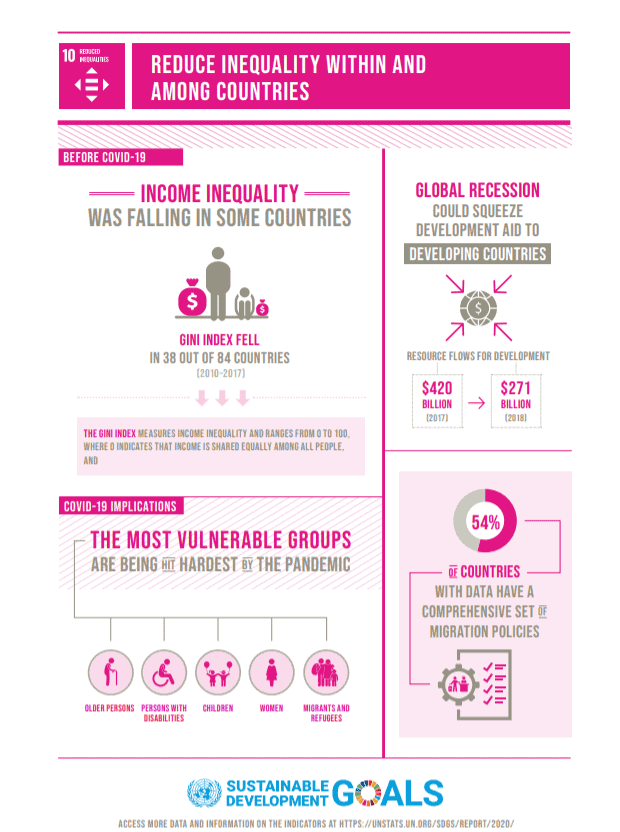
- Evidence from developing countries shows that children in the poorest 20 per cent of the populations are still up to three times more likely to die before their fifth birthday than children in the richest quintiles.
- Social protection has been significantly extended globally, yet persons with disabilities are up to five times more likely than average to incur catastrophic health expenditures.
- Despite overall declines in maternal mortality in most developing countries, women in rural areas are still up to three times more likely to die while giving birth than women living in urban centers.
- Up to 30 per cent of income inequality is due to inequality within households, including between women and men. Women are also more likely than men to live below 50 per cent of the median income
- Of the one billion population of persons with disabilities, 80per cent live in developing countries.
- One in ten children is a child with a disability.
- Only 28 per cent of persons with significant disabilities have access to disability benefits globally, and only 1per cent in low-income countries.
United Nations SDG 11 : Sustainable cities and Communities

- Half of humanity – 3.5 billion people – lives in cities today and 5 billion people are projected to live in cities by 2030.
- 95 per cent of urban expansion in the next decades will take place in developing world
- 828 million people live in slums today and most them are found in Eastern and South-Eastern Asia.
- The world’s cities occupy just 3 per cent of the Earth’s land, but account for 60-80 per cent of energy consumption and 75 per cent of carbon emissions.
- Rapid urbanization is exerting pressure on fresh water supplies, sewage, the living environment, and public health.
- Cities account for between 60 and 80 per cent of energy consumption and generate as much as 70per cent of human-induced greenhouse gas emissions
- 90 per cent of urban growth is forecasted to happen in Asia and Africa in the next 30 years.
- By 2050 70 per cent of the world population is predicted to live in urban settlements.
United Nations SDG 12 : Responsible consumption and Production
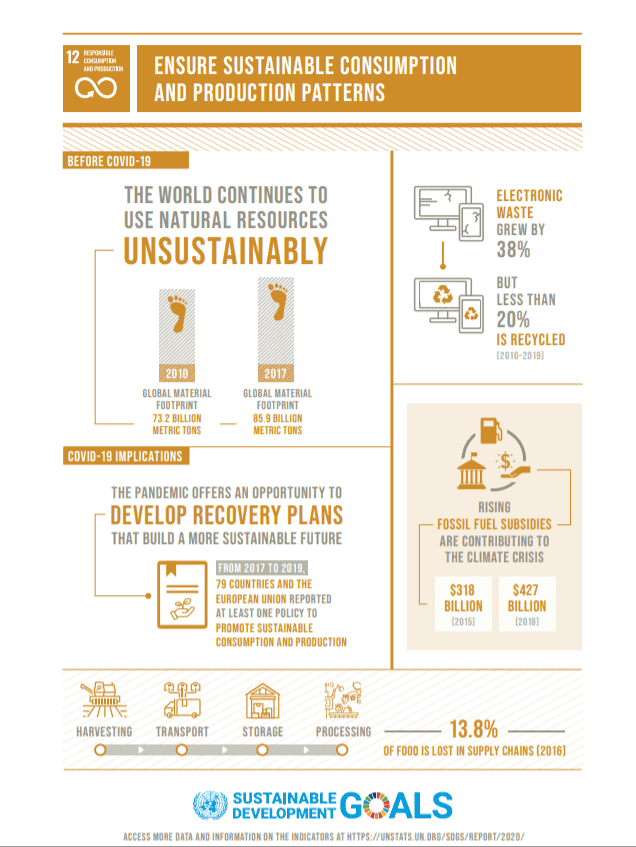
- According to latest projections, the global population could grow to around 8.5 billion in 2030, 9.7 billion in 2050. The equivalent of almost three planets could be required to provide the natural resources needed to sustain current lifestyles.
- 93 per cent of the world’s 250 largest companies are now reporting on sustainability.
Water
- Less than 3 per cent of the world’s water is fresh (drinkable), of which 2.5 per cent is frozen in the Antarctica, Arctic and glaciers. Humanity must therefore rely on 0.5 per cent for all of man’s ecosystem’s and freshwater needs.
- Humankind is polluting water in rivers and lakes faster than nature can recycle and purify
- More than 1 billion people still do not have access to fresh water.
- Excessive use of water contributes to the global water stress.
- Water is free from nature, but the infrastructure needed to deliver it is expensive.
- Water use has been increasing worldwide by about 1per cent per year since the 1980s.
- Agriculture (including irrigation, livestock and aquaculture) is by far the largest water consumer, accounting for 69per cent of annual water withdrawals globally. Industry (including power generation) accounts for 19per cent and households for 12per cent.
- Over 2 billion people live in countries experiencing high water stress.
- Over the period 1995–2015, floods accounted for 43per cent of all documented natural disasters, affecting 2.3 billion people, killing 157,000 more and causing US$662 billion in damage.
- Three out of ten people (2.1 billion people, or 29per cent of the global population) did not use a safely managed drinking water service4 in 2015, whereas 844 million people still lacked even a basic drinking water service.
Energy
- If people worldwide switched to energy efficient lightbulbs, the world would save US$120 billion annually.
- Despite technological advances that have promoted energy efficiency gains, energy use in OECD countries will continue to grow another 35 per cent by 2020. Commercial and residential energy use is the second most rapidly growing area of global energy use after transport.
- In 2002 the motor vehicle stock in OECD countries was 550 million vehicles (75 per cent of which were personal cars). A 32 per cent increase in vehicle ownership is expected by 2020. At the same time, motor vehicle kilometers are projected to increase by 40 per cent and global air travel is projected to triple in the same period.
- Households consume 29 per cent of global energy and consequently contribute to 21 per cent of resultant CO2 emissions.
- The share of renewable energy in final energy consumption has reached 17.5per cent in 2015.
- The global electrification rate reached 89per cent in 2017 (from 83per cent in 2010), still leaving about 840 million people without access
- Between 2010 and 2017, the percentage of the population relying on clean cooking solutions grew by an annual average of 0.5 percentage points.
- The global population without access to electricity fell from 1.2 billion in 2010 to 840 million in 2017.
Food
- Each year, an estimated 1/3 of all food produced – equivalent to 1.3 billion tons worth around $1 trillion – ends up rotting in the bins of consumers and retailers, or spoiling due to poor transportation and harvesting practices
- 38 million children under the age of 5 were overweight or obese in 2019.
- Land degradation, declining soil fertility, unsustainable water use, overfishing and marine environment degradation are all lessening the ability of the natural resource base to supply food.
- The food sector accounts for around 30 per cent of the world’s total energy consumption and accounts for around 22 per cent of total Greenhouse Gas emissions.
United Nations SDG 13 : Climate Action

- As of April 2018, 175 parties had ratified the Paris Agreement and 168 parties had communicated their first nationally determined contributions to the UN framework convention on Climate Change Secretariat.
- As of April 2018, 10 developing countries had successfully completed and submitted their first iteration of their national adaptation plans for responding to climate change.
- Developed country parties continue to make progress towards the goal of jointly mobilizing $100 billion annually by 2020 for mitigation actions.
Thanks to the Intergovernmental Panel on Climate Change we know:
- From 1880 to 2012, average global temperature increased by 0.85°C. To put this into perspective, for each 1 degree of temperature increase, grain yields decline by about 5 per cent. Maize, wheat and other major crops have experienced significant yield reductions at the global level of 40 megatons per year between 1981 and 2002 due to a warmer climate.
- Oceans have warmed, the amounts of snow and ice have diminished and sea level has risen.From 1901 to 2010, the global average sea level rose by 19 cm as oceans expanded due to warming and ice melted. The Arctic’s sea ice extent has shrunk in every successive decade since 1979, with 1.07 million km² of ice loss every decade
- Given current concentrations and on-going emissions of greenhouse gases, it is likely that by the end of this century, the increase in global temperature will exceed 1.5°C compared to 1850 to 1900 for all but one scenario. The world’s oceans will warm and ice melt will continue. Average sea level rise is predicted as 24 – 30cm by 2065 and 40-63cm by 2100. Most aspects of climate change will persist for many centuries even if emissions are stopped
- Global emissions of carbon dioxide (CO2) have increased by almost 50 per cent since 1990
- Emissions grew more quickly between 2000 and 2010 than in each of the three previous decades
- It is still possible, using a wide array of technological measures and changes in behavior, to limit the increase in global mean temperature to two degrees Celsius above pre-industrial levels
- Major institutional and technological change will give a better than even chance that global warming will not exceed this threshold
United Nations SDG 14 : Life below Water
- Oceans cover three quarters of the Earth’s surface, contain 97 per cent of the Earth’s water, and represent 99 per cent of the living space on the planet by volume.
Climate change
- Oceans absorb about 30 per cent of carbon dioxide produced by humans, buffering the impacts of global warming.
- Carbon emissions from human activities are causing ocean warming, acidification and oxygen loss.
- The ocean has also absorbed more than 90per cent of the excess heat in the climate system.
- Ocean heat is at record levels, causing widespread marine heatwaves.
Ocean and people
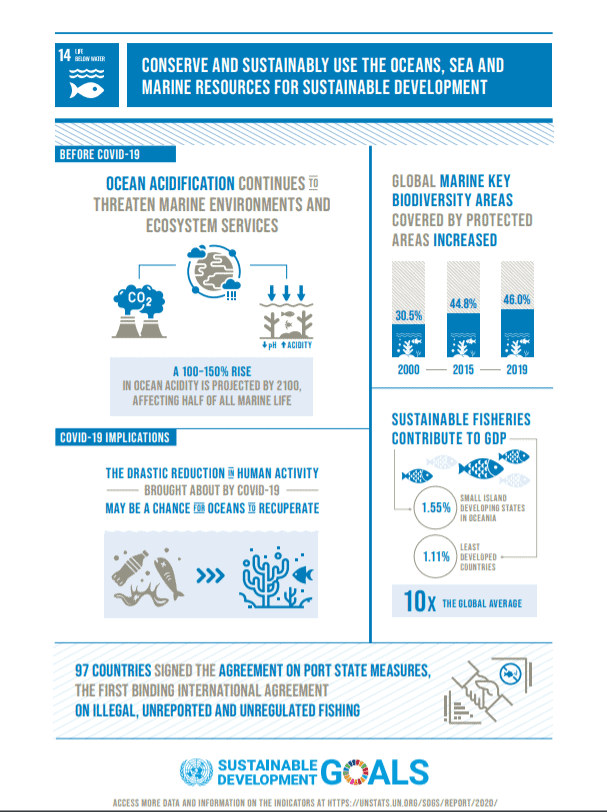
- Over three billion people depend on marine and coastal biodiversity for their livelihoods.
- Globally, the market value of marine and coastal resources and industries is estimated at $3 trillion per year or about 5 per cent of global GDP.
- Marine fisheries directly or indirectly employ over 200 million people.
- Coastal waters are deteriorating due to pollution and eutrophication. Without concerted efforts, coastal eutrophication is expected to increase in 20 percent of large marine ecosystems by 2050.
- Roughly 80per cent of marine and coastal pollution originates on land – including agricultural run-off, pesticides, plastics and untreated sewage.
- Around the world, one million plastic drinking bottles are purchased every minute, while up to 5 trillion single-use plastic bags are used worldwide every year
- Around 680 million people live in low-lying coastal zones – that is expected to increase to a billion by 2050.
- Sustainable and climate-resilient transport, including maritime transport, is key to sustainable development. Around 80 per cent of the volume of international trade in goods is carried by sea, and the percentage is even higher for most developing countries
United Nations SDG 15 : Life on Land
- Human activity has altered almost 75 per cent of the earth’s surface, squeezing wildlife and nature into an ever-smaller corner of the planet and increasing risks of zoonotic diseases like COVID-19.
Forests
- Around 1.6 billion people depend on forests for their livelihood, including 70 million indigenous people.
- Forests are home to more than 80 per cent of all terrestrial species of animals, plants and insects.
- Between 2010 and 2015, the world lost 3.3 million hectares of forest areas. Poor rural women depend on common pool resources and are especially affected by their depletion.
- Currently, land degradation has reduced productivity in 23 per cent of the global terrestrial area, and between $235 billion and $577 billion in annual global crop output is at risk as a result of pollinator loss.
Desertification
- Arable land loss is estimated at 30 to 35 times the historical rate
- Due to drought and desertification, 12 million hectares are lost each year (23 hectares per minute). Within one year, 20 million tons of grain could have been grown.
- 74 per cent of the poor are directly affected by land degradation globally.
- Habitat loss and deterioration, largely caused by human actions, have reduced global terrestrial habitat integrity by 30 per cent relative to an unimpacted baseline.
Biodiversity
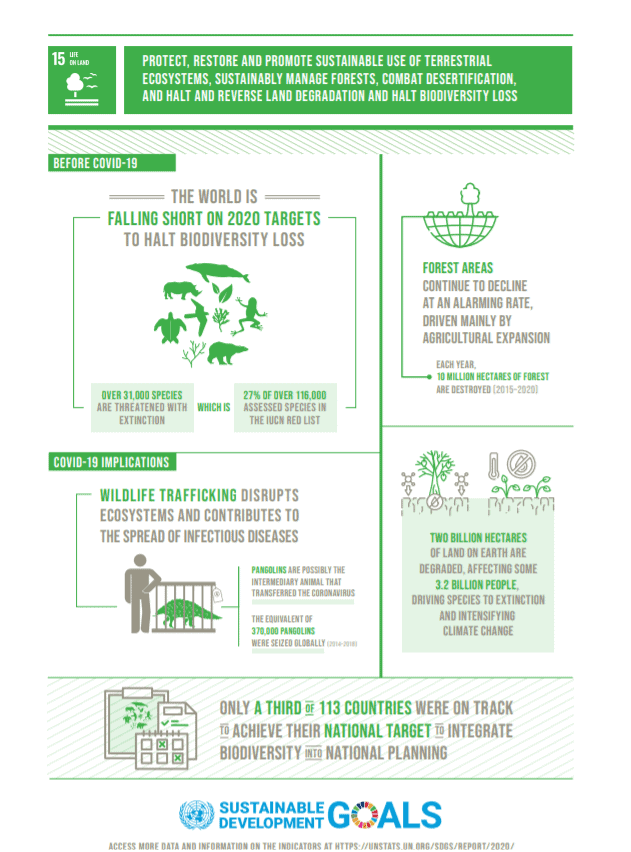
- Illicit poaching and trafficking of wildlife continues to thwart conservation efforts, with nearly 7,000 species of animals and plants reported in illegal trade involving 120 countries.
- Of the 8,300 animal breeds known, 8 per cent are extinct and 22 per cent are at risk of extinction.
- Of the over 80,000 tree species, less than 1 per cent have been studied for potential use.
- Fish provide 20 per cent of animal protein to about 3 billion people. Only ten species provide about 30 per cent of marine capture fisheries and ten species provide about 50 per cent of aquaculture production.
- Over 80 per cent of the human diet is provided by plants. Only three cereal crops – rice, maize and wheat – provide 60 per cent of energy intake.
- As many as 80 per cent of people living in rural areas in developing countries rely on traditional plant-‐based medicines for basic healthcare.
- Micro-organisms and invertebrates are key to ecosystem services, but their contributions are still poorly known and rarely acknowledged.
- While protected areas now cover 15 per cent of terrestrial and freshwater environments and 7 per cent of the marine realm, they only partly cover important sites for biodiversity and are not yet fully ecologically representative and effectively or equitably managed.
United Nations SDG 16 : Peace, Justice and Strong institutions
- Among the institutions most affected by corruption are the judiciary and police.
- Corruption, bribery, theft and tax evasion cost some US $1.26 trillion for developing countries per year; this amount of money could be used to lift those who are living on less than $1.25 a day above $1.25 for at least six years
- Birth registration has occurred for 73 per cent of children under 5, but only 46per cent of Sub-Saharan Africa have had their births registered.
- Approximately 28.5 million primary school age who are out of school live in conflict-affected areas.
- The rule of law and development have a significant interrelation and are mutually reinforcing, making it essential for sustainable development at the national and international level.
- The proportion of prisoners held in detention without sentencing has remained almost constant in the last decade, at 31per cent of all prisoners.
Violence against children
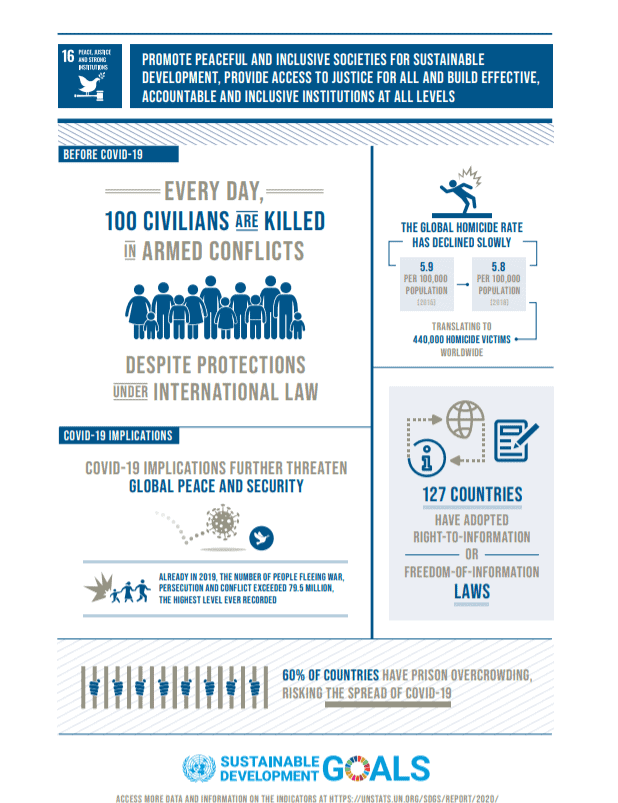
- The number of people fleeing war, persecution and conflict exceeded 70 million in 2018, the highest level recorded by the UN refugee agency (UNHCR) in almost 70 years.
- In 2019, the United Nations tracked 357 killings and 30 enforced disappearances of human rights defenders, journalists and trade unionists in 47 countries.
- Violence against children affects more than 1 billion children around the world and costs societies up to US$ 7 trillion a year.
- 50 per cent of the world’s children experience violence every year.
- Every 7 minutes, somewhere in the world, a child is killed by violence
- 1 in 10 children is sexually abused before the age of 18.
- 9 in 10 children live in countries where corporal punishment is not fully prohibited, leaving 732 million children without legal protection.
- 1 in 3 internet users worldwide is a child and 800 million of them use social media. Any child can become a victim of online violence.
- Child online sexual abuse reports to NCMEC has grown from 1 million in 2014 to 45 million in 2018.
- 246 million children worldwide affected by school-related violence each year.
- 1 in 3 students has been bullied by their peers at school in the last month, and at least 1 in 10 children have experienced cyberbullying.
United Nations SDG 17 : Partnerships for the goals
- Net Official Development Assistance flows by member countries of the Development Assistance Committee (DAC) of the Organization for Economic Cooperation and Development totaled $147.4 billion in 2019.
- 79 per cent of imports from developing countries enter developed countries duty-free
- The debt burden on developing countries remains stable at about 3 per cent of export revenue
- Trade, foreign direct investment and remittances all projected to decline by up to 40 per cent in 2020.
- Almost half of the world’s population is not connected to the internet, particularly in poor countries.
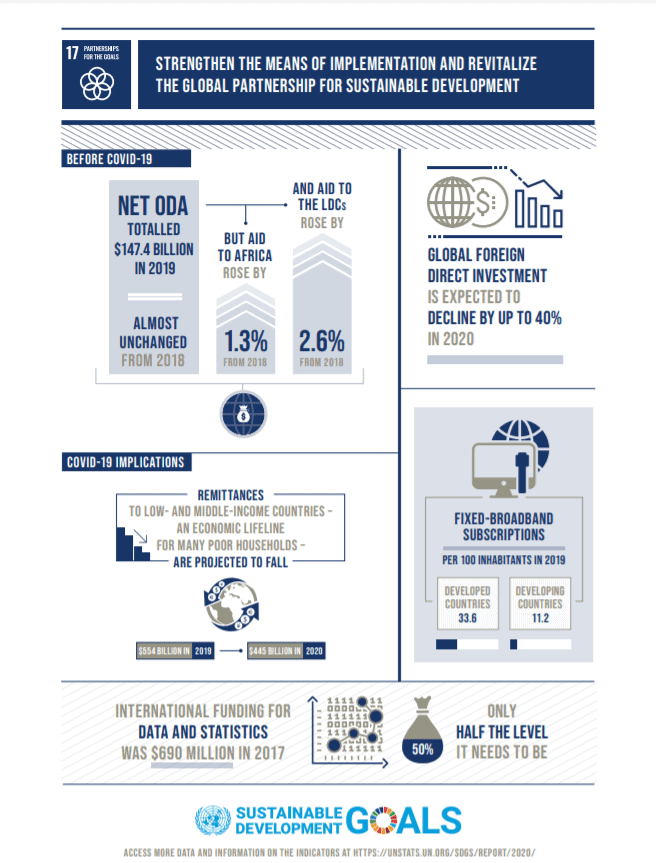
USE THIS FACT CHEAT TO BOOST YOUR IAS SCORE
- Whenever you use any of these facts, start your sentence with – “According to the United Nations…”
- Remember to use them in the appropriate places
- Instead of memorizing these all at once, look at all 17 inforgraphics repeatedly and use the imagery in them to form a picture of that particular global problem.
- Try to correlate the same with India and think of how well India is doing on all these fronts.
- Remember that the perspective given by these facts is more important the number and digits.
- Try to find nifty and useful Infographics for General Studies and learn by visualization instead of only reading text.
I hope this was helpful!
I wish you all the Best for the upcoming exams.

If not for Baba Powers what would my life turn out to be? I want you all to please contact Baba Powers now to get the powerful black mirror from him. I want you all to also BELIEVE AND TRUST HIM because whatever he tells you is the TRUTH and 100% guaranteed. The black mirror makes it happen, attracts abundance. I bought the black mirror from Baba Powers and now, I am super rich and successful with the help of the black mirror. When I first saw the testimonies of Baba Powers of the black mirror, I thought it was a joke but I contacted him to be sure for myself and to my greatest surprise, the black mirror is real. The black mirror is powerful. Check him out on his website to see plenty of amazing testimonies from people about him. These are some of the people that he has helped. Here is his website; Babablackmirrorsofpowers.blogspot.com and here is his email; Babablackmirrors@gmail.com I really can’t thank you enough Baba Powers. God bless you, thank you. Contact him and he will help you
Very useful.
It is very useful thank you very much Sir ?
Thank you a lot sir